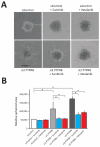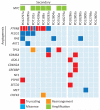Recurrent PTPRB and PLCG1 mutations in angiosarcoma
- PMID: 24633157
- PMCID: PMC4032873
- DOI: 10.1038/ng.2921
Recurrent PTPRB and PLCG1 mutations in angiosarcoma
Abstract
Angiosarcoma is an aggressive malignancy that arises spontaneously or secondarily to ionizing radiation or chronic lymphoedema. Previous work has identified aberrant angiogenesis, including occasional somatic mutations in angiogenesis signaling genes, as a key driver of angiosarcoma. Here we employed whole-genome, whole-exome and targeted sequencing to study the somatic changes underpinning primary and secondary angiosarcoma. We identified recurrent mutations in two genes, PTPRB and PLCG1, which are intimately linked to angiogenesis. The endothelial phosphatase PTPRB, a negative regulator of vascular growth factor tyrosine kinases, harbored predominantly truncating mutations in 10 of 39 tumors (26%). PLCG1, a signal transducer of tyrosine kinases, encoded a recurrent, likely activating p.Arg707Gln missense variant in 3 of 34 cases (9%). Overall, 15 of 39 tumors (38%) harbored at least one driver mutation in angiogenesis signaling genes. Our findings inform and reinforce current therapeutic efforts to target angiogenesis signaling in angiosarcoma.
Figures



References
Publication types
MeSH terms
Substances
Grants and funding
LinkOut - more resources
Full Text Sources
Other Literature Sources
Miscellaneous

